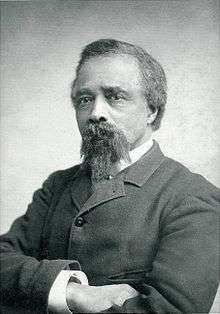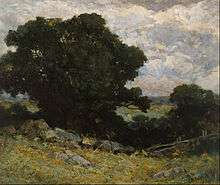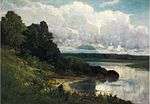Edward Mitchell Bannister
| Edward Mitchell Bannister | |
|---|---|
 Rhode Island Black Heritage Society (carte de visite) | |
| Born |
1828 New Brunswick, Canada |
| Died | January 9, 1901 |
| Resting place | North Burial Ground, Providence |
| Nationality | American |
| Known for | Painting |
| Movement | Tonalism |
Edward Mitchell Bannister (ca. 1828 – January 9, 1901) was a Black Canadian-American Tonalist painter. Like other Tonalists, his style and predominantly pastoral subject matter were drawn from his admiration for Millet and the French Barbizon School.
Biography

Bannister was born in St. Andrews, New Brunswick and moved to New England in the late 1840s, where he remained for the rest of his life. While Bannister was well known in the artistic community of his adopted home of Providence, Rhode Island and admired within the wider East Coast art world (he won a bronze medal for his large oil "Under the Oaks" at the 1876 Philadelphia Centennial), he was largely forgotten for almost a century for a complexity of reasons, principally connected with racial prejudice.
With the ascendency of the Civil Rights Movement in the 1970s, his work was again celebrated and collected. In 1978, Rhode Island College dedicated its Art Gallery in Bannister's name with the exhibition: "Four From Providence ~ Alston, Bannister, Jennings & Prophet". This event was attended and commented on by numerous notable political figures of the time, and supported by the Rhode Island Committee for Humanities and the Rhode Island Historical Society. Events like this, across the entire cultural landscape, have ensured that his artwork and life will not be again forgotten.
Although primarily known for his idealised landscapes and seascapes, Bannister also executed portraits, biblical and mythological scenes, and genre scenes. An intellectual autodidact, his tastes in literature were typical of an educated Victorian painter, including Spenser, Virgil, Ruskin and Tennyson, from whose works much of his iconography can be traced.
Bannister died of a heart attack in 1901 while attending a prayer meeting at his church, Elmwood Avenue Free Baptist Church. He is buried in the North Burial Ground in Providence.
Legacy
The historian Anne Louise Avery is currently compiling the first Catalogue Raisonné and major biography of Bannister's work. See the International Foundation for Art Research for further details.
E. M. Bannister Gallery at Rhode Island College is named after Bannister.[1]
House
The house at 93 Benevolent Street in Providence, where Bannister lived between 1884 and 1899, was owned by Brown University until 2016. Brown renovated the property and restored it to its original appearance,[2] and it was sold to Professor Jeff Huang as part of the Brown to Brown Home Ownership Program.
Important works
- The Newsboy [Boston Newsboy] [Newspaper Boy] (1869; Oil; 30 1/8 x 25 inches; SAAM, Washington D.C.)[3]
- River Scene (1883; Oil on canvas; Honolulu Museum of Art)
- Sabin Point, Narragansett Bay (1885; Oil on canvas; Gardner House, Providence, Rhode Island)
- Palmer River (1885; Oil on canvas; Private Collection)
Gallery
_-_Walters_372766.jpg) Boston Street Scene (Boston Common), (1898–99). The Walters Art Museum.
Boston Street Scene (Boston Common), (1898–99). The Walters Art Museum. Newspaper Boy, 1869, Smithsonian American Art Museum
Newspaper Boy, 1869, Smithsonian American Art Museum Driving Home the Cows, 1881, Smithsonian American Art Museum
Driving Home the Cows, 1881, Smithsonian American Art Museum- River Scene by Edward Mitchell Bannister, 1883, oil on canvas, Honolulu Museum of Art
 Palmer River, 1885[4]
Palmer River, 1885[4]
Notes
- ↑ "Edward Mitchell Bannister". Rhode Island College. Retrieved 2014-03-16.
- ↑ Coelho, Courtney (13 May 2015). "Brown to renovate historic Bannister House". News from Brown. Brown University. Retrieved 15 May 2015.
The house at 93 Benevolent Street, once home to African American artist Edward Mitchell Bannister and currently owned by Brown University, will be fully renovated, returned to its original wood exterior ...
- ↑ "Newspaper Boy by Edward Mitchell Bannister / American Art". si.edu. Retrieved 2 May 2015.
- ↑ "Palmer River". The Athenaeum. Retrieved 5 August 2015.
Bibliography
- Bannister, Edward Mitchell. Edward M. Bannister: A Centennial Retrospective. Newport, R.I.: Roger King Gallery of Fine Art, 2001. OCLC 49568395 Edward M. Bannister: a centennial retrospective. (WorldCat.org)
- Romare Bearden and Harry Henderson, A History of African American Artists from 1792 to the Present, (Pantheon, 1993).
- Holland, Juanita Marie and Corinne Jennings, Edward Mitchell Bannister, 1828-1901, New York, Harry N. Abrams, 1992, ISBN 0810968118
External links
| Wikimedia Commons has media related to Edward Mitchell Bannister. |
- Edward Mitchell Bannister at American Art Gallery
- White Mountain Art
- African Americans in the Visual Arts
- Biographical sketch and images at World Wide Art Resources
- Narratives of Art and Identity: The David C. Driskell Collection
- Edward Mitchell Bannister at Find a Grave
- "'The Vault' on Benevolent St. remains closed, for now". The Brown Daily Herald. September 29, 2010. Retrieved 2010-09-30.
- Selections of nineteenth-century Afro-American Art, an exhibition catalog from The Metropolitan Museum of Art (fully available online as PDF), which contains material on Bannister (no. 13-14)